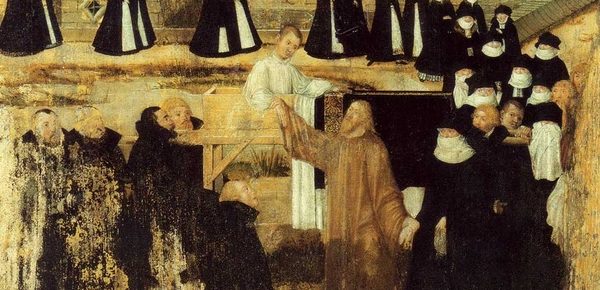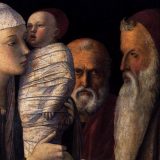Each week I print out the readings for the week for you to follow and take home. This week I’ve added an explanatory sentence at the beginning of each lesson to give you more information about the background and history of the readings. Each week a sermon is preached on the readings for the week. Christians all around the world do the same thing – very many of them will have the same readings as us. A lot of store is put onto these readings from the Bible, and that is because we believe the Bible is God’s word to us. The Gospel readings doubly so as we read the written word and hear about the living word who is Jesus, our savior.
Sometimes the readings are hard for us to accept or understand, and I think this is the case today. There are no long words or complicated sentences, and we’ve heard this story so often we might not really think about it any more. But this story is hard for us to understand because Jesus brings a dead person back to life with just a touch of his hand – no defibrillator or operating table, no nurses or doctors, no hospital. Just Jesus and a widow’s only son, just Jesus’ hands and a few words and death releases its latest victim – a young man is restored to life.
There are all sorts of explanations about this story and what it’s about. It parallels, as you may have noticed, the old testament reading about Elijah who also raised a widow’s son from the dead. Luke is giving us a clue about Jesus when he tells the story as he does. In Jewish tradition the return of Elijah ushers in the messianic age. Matthew and Mark both depict John the Baptist as Elijah, suggesting that Jesus is the Messiah. Luke, whose gospel we are focussing on this year, depicts Jesus himself as an Elijah figure. Their message is the same – the Messiah is here.This story is a good example of subtle links between Jesus and Elijah in Luke’s gospel. Here we are being told that the messianic age is dawning – God has come to his people. This is a really important coded message hidden in today’s gospel reading.
It becomes, perhaps, a little easier for us to understand how this miracle happened if we believe, as Luke is suggesting, that Jesus is the Messiah. As such he can do anything, including resurrection miracles. Many in today’s world mock Christians and others for believing in miracles. To them this seems like a fairy story. It might even stretch some of us on occasions. In our scientific age we have become very sceptical about the miraculous and the mysterious. Maybe this is our arrogance – we feel we know so much that we have no room left for mystery. Our ancestors knew that the world was a mysterious and magical place and approached it with fear and trepidation, and sometimes a sense of wonder. Somehow we’ve lost this. We have become arrogant, thinking we know so much when, in truth, we know very little indeed.
Even with the knowledge we do have, there is still lots of room left in our faith and in our world for that which is mysterious, incomprehensible, magical. It is possible to hold scientific knowledge and a sense of wonder and mystery together. We now know that the earth spins around the sun, other planets echoing this orbit at different speeds. We know the moon revolves around the earth and that space is vast and seemingly endless. We know this but it doesn’t mean we’re not moved by sunsets, awed by the night sky, or filled with wonder by the slim crescent of the moon in the evening sky.
This story should fill us with a similar sense of wonder at the power that Jesus had, and exactly how he used it. We know that Jesus was tested by the devil who tried to persuade him to use his power selfishly, for his own gain. Here we see what it looks like for someone to use their power for good – a very rare thing indeed. There are some clues for us too – suggestions for how we might follow in Jesus’ footsteps.
First of all we learn that Jesus noticed – he paid attention. He was surrounded by a large crowd. Another large crowd – the funeral procession – was coming the other way. The two met at the town gate. A woman was weeping – actually that’s a bit polite. The Greek world is more like wailing. Jesus notices her pain. This is something we need to do too – simply to notice. So often we go about our lives as if people are invisible – the person behind the supermarket till, the beggar in the doorway, a colleague who’s looking tired or ill or upset, or even someone whose been absent from work or church. Jesus paid attention and we need to as well. Never mind mindfulness, our faith demands that we pay attention.
After he notices the wailing woman, Jesus has compassion. Again, our translation is rather polite. The Greek word comes from a noun ‘splanxna,’ meaning your bowels, heart, lungs, liver or kidneys, which in that day were the centre of human emotions. Jesus was gut-wrenched about this woman. He was brimming over with compassion. He was stirred and shaken. He was really upset. Not only had this woman lost her husband and her son, but she was now in an extremely difficult social position – the way things worked in those days she would very likely have ended up begging or worse. Women didn’t just go out to work or get their husbands pension. This woman would have been completely destitute. Jesus entered into her world and shared her pain. This behaviour reflects our belief in incarnation – God in human form, God sharing human life, knowing our pain and sharing out sorrows. This is the meaning of Christmas and it’s not even a tiny bit twee or sentimental. Incarnation hurts. Compassion hurts too.
Of course, the next thing – raising someone from the dead – we can’t do. Sometimes miracles DO happen – at least 2 of the people on our prayer list are now cancer free. This has been achieved through medical intervention – our beloved NHS – but these are still miracles. Putting miracles aside think the noticing and feeling will keep us quite busy. And we and should can act in smaller, humbler ways. We can’t raise people from the dead but we can be Jesus’ hands and feet and eyes – even his gut – in many other ways. We’re not miracle workers, but we can do plenty of other things to put our noticing and our compassion into action.
As Jesus’s followers we can learn the principles of wonder, of noticing and of feeling. And we can DO many things. As we do these things the Kingdom of God draws closer, the messianic age dawns.
Rev’d Anne Morris
CProper5





